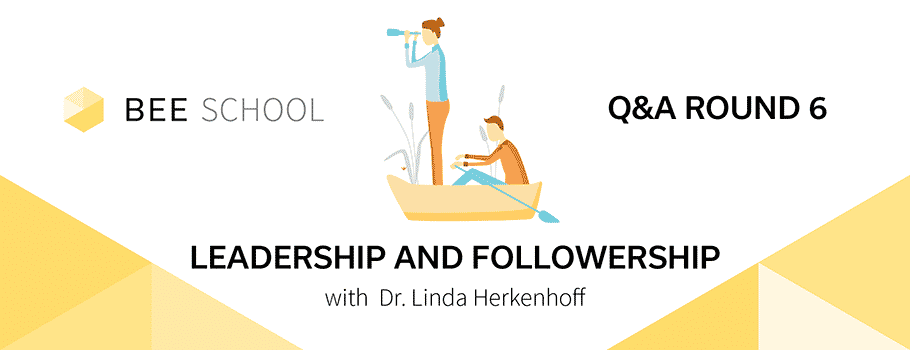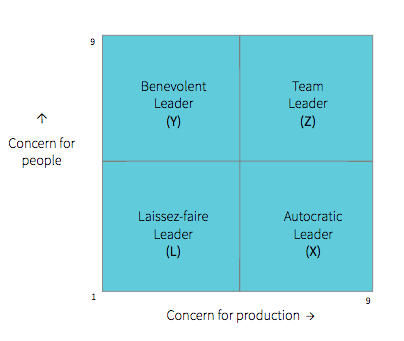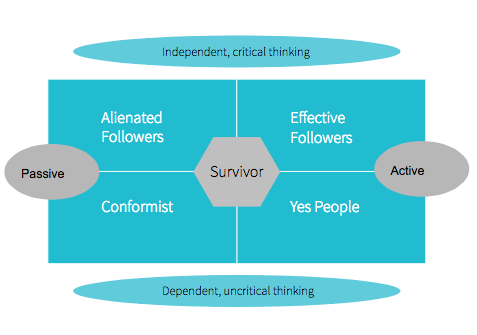Class is dismissed!
Sadly, Bee School has ended with Dr. Herkenhoff’s lecture on “Leadership and Followership,” but we have a few more insights to share on Bee intelligence.
Difference Between Leadership and Followership
In the final session titled “Leadership and Followership,” Dr. Herkenhoff explains the qualities of each, why they are essential, and how to improve in both areas.
First, she dives into leadership—the act of guiding and directing others. She explains the differences between formal and informal leadership, and identifies the four types of leaders with examples, pros, and cons of each.
Leadership Styles and Emotional Intelligence Charts
Expanding on her last lecture on “Emotional Intelligence,” she reveals her research findings that good leaders have the technical know-how and high IQ, but great leaders have those and a high EQ. That is the ultimate differentiator, along with knowing how to build communities.
Below are what she deems as the most important leadership skills:
-
- Tolerance for ambiguity
- Frazzle factor (stress)
- Risk-taking
- Feedback
Remember: People join companies, but leave managers. Be a great manager and you will retain your people.
Followership
On the flip side of leadership, followership is the process of being guided and directed. Many people consider the term “follower” as negative, but that it simply not the case. Effective followers have the power to improve organizations and influence their leaders. We are all followers at some point, so these skills are essential for each and every one of us.
The professor outlines the four types of followers and pros and cons of each to prove her case.
Types of Followers

There were two great questions asked during the presentation and below are Dr. Herkenhoff’s responses. If you have any further questions or feedback about Bee School, or want us to send you the recording, email us at beeschool@beekeeper.io.
Q&A with the Professor
1. Do good leaders need to be good followers?
Absolutely. Being a good follower doesn’t make you a sheep. There are many traits learned as a follower that make better leaders.
Collaboration is the key to success. Leaders who have learned how to work with people and bring out the best in them will create a strong culture and have an easier time motivating teams to accomplish goals. Similar to collaboration, diplomacy means knowing how to get along with those who have differences while not ignoring those differences. Leaders can’t afford to be oblivious to the attitudes surrounding them.
It is this awareness that is learned while being a follower that allows leaders to take into account their various audiences including colleagues, board members, customers, and coworkers. A good leader knows each of their stakeholder groups well enough to know what it will take to bring them along for the ride.
Collaboration, diplomacy, and awareness are great, but critical thinking and knowing when to stand up to their leaders is an admirable trait learned as a follower. It is this motivation, intelligence, and competence that inspires followership.
Standing up to your leaders at every point in your career when you think things are heading in the wrong direction takes courage. This requires critical thinking and awareness of the situation to get your point across with the conviction and energy needed to change what is wrong, as well as support a leader or manager who is doing things well.
2. What is the best process for delivering and receiving feedback?
Delivering feedback is one of the most difficult things for people to do, so when you receive feedback, the first thing you should say is “thank you.” The courage that it takes to give any feedback is significant. The fact someone took the time and effort to make you better deserves to be treated with appreciation.
After receiving feedback and thanking the person, take a minute to reflect and do your best to remove your personal emotions from any response. If you need more time to digest the feedback, let the person know you would like to sleep on their comments before responding.
Giving feedback can be accomplished in three simple statements:
-
-
- Deliver the data – not your opinions.
- Let the person know how this made you feel.
- State your wish for how you would like to see things changed for the future. If this is a manager giving performance feedback, this is the time to also deliver a fitting consequence if the situation is not resolved.
-
Here is an example:
-
-
- Mary, last week in our team meeting I requested you submit your TPS report by this Monday. It is Wednesday and I still haven’t seen your report.
- I am frustrated that I wasn’t heard asking for the report or informed about a delay in the process of delivering it to me.
- My wish for the future is that you meet deadlines that are asked of you or you communicate in advance why you can’t meet the deadline. I would like this report submitted by noon tomorrow. If I do not receive your reports on time, I will not approve your future requests to leave a few minutes early.
-
You can finish by thanking the person for accepting your feedback and be willing for it to work the other way around (minus the consequences part).
Did you find the information from Bee School helpful? Fill out the form below to catch replays and learn more about Beekeeper.









